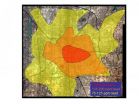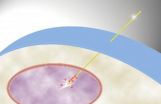(Press-News.org) Elevated concentrations of nitrogen and phosphorus, nutrients that can negatively impact aquatic ecosystems and human health, have remained the same or increased in many streams and aquifers across the Nation since the early 1990's, according to a new national study by the U.S. Geological Survey.
"This USGS report provides the most comprehensive national-scale assessment to date of nitrogen and phosphorus in our streams and groundwater," said Marcia McNutt, USGS Director. "For years we have known that these same nutrients in high concentrations have resulted in 'dead zones' when they reach our estuaries, such as during the spring at the mouth of the Mississippi, and now we have improved science-based explanations of when, where, and how elevated concentrations reach our streams and aquifers and affect aquatic life and the quality of our drinking water."
"Despite major Federal, State and local efforts and expenditures to control sources and movement of nutrients within our Nation's watersheds, national-scale progress was not evident in this assessment, which is based on thousands of measurements and hundreds of studies across the country from the 1990's and early 2000's," said Matthew C. Larsen, USGS Associate Director for Water.
According to the U.S. Environmental Protection Agency, nutrient pollution has consistently ranked as one of the top three causes of degradation in U.S. streams and rivers for decades.
USGS findings show that widespread concentrations of nitrogen and phosphorus remain two to ten times greater than levels recommended by the EPA to protect aquatic life. Most often, these elevated levels were found in agricultural and urban streams. These findings show that continued reductions in nutrient sources and implementation of land-management strategies for reducing nutrient delivery to streams are needed to meet EPA recommended levels in most regions.
Nutrients occur naturally in water and are needed for plant growth and productive aquatic ecosystems; however, in high concentrations nutrients often result in the growth of large amounts of algae and other nuisance plants in streams, lakes and estuaries. The decay of these plants and algae can cause areas of low dissolved oxygen, known as hypoxic, or "dead," zones that stress or kill aquatic life. Some forms of algae release toxins that can result in health concerns.
The study also found that nitrate is a continuing human-health concern in many shallow aquifers across the Nation that are sources of drinking water. In agricultural areas, more than one in five shallow, private wells contained nitrate at levels above the EPA drinking water standard. The quality and safety of water from private wells—which are a source of drinking water for about 40 million people—are not regulated by the Federal Safe Drinking Water Act and are the responsibility of the homeowner.
Because nitrate can persist in groundwater for years and even decades, nitrate concentrations are likely to increase in aquifers used for public drinking-water supplies during at least the next decade, as shallow groundwater with high nutrient concentrations moves downward into deeper aquifers.
"Strategies designed to reduce nutrient inputs on the land will improve the quality of water in near-surface parts of aquifers; however, decades may pass before quality improves in deeper parts of the aquifer, which serve as major sources for public-supply wells," said Neil Dubrovsky, USGS hydrologist and lead scientist on this study. "Unfortunately, similar time delays for improvements are expected for streams that receive substantial inputs of groundwater."
A variety of sources can contribute nutrients to surface and groundwater, such as wastewater and industrial discharges, fertilizer and manure applications to agricultural land, runoff from urban areas, and atmospheric sources. USGS findings show that nutrient sources and resulting concentrations vary across the Nation. For example, concentrations of nitrogen generally are highest in agricultural streams in the Northeast, Midwest, and the Northwest, which have some of the most intense applications of fertilizer and manure in the Nation.
Differences in concentrations across the Nation also are due to natural features and human activities. For example, concentrations of nitrogen in streams draining parts of the agricultural Midwest are increased by contributions from artificial subsurface tile drains that are used to promote rapid dewatering of poorly drained soils. Conversely, concentrations of nitrate in streams draining parts of the Southeast appear to dissipate faster as a result of enhanced natural removal processes in soils and streams.
"This nationwide assessment of sources and natural and human factors that control how nutrients enter our streams and groundwater helps decision-makers anticipate where watersheds are most vulnerable to contamination and set priorities and management actions in different geographic regions of the country," said Dubrovsky.
INFORMATION:
For more than 125 years, the USGS has served as the Nation's water monitoring agency, including flow and (or) quality in selected streams and rivers across the U.S. USGS continues to work closely with the EPA, U.S. Department of Agriculture, the States, and local watersheds to assure that USGS monitoring and assessments provide useful information for managing nutrients throughout the Nation.
Water-quality data from more than 1,300 locations, much of it in real-time, is available through USGS Water Quality Watch at http://waterwatch.usgs.gov/wqwatch/. Additional information about surface water, groundwater and water quality is available at National Water Information System Web Interface at http://waterdata.usgs.gov/nwis/. You can also receive instant, customized updates about water conditions by subscribing to WaterAlert, a new service from the USGS, at http://water.usgs.gov/wateralert.
Complete findings, as well as a USGS fact sheet, podcast, and graphics are available at http://water.usgs.gov/nawqa/nutrients/pubs/circ1350/.
USGS provides science for a changing world. Visit USGS.gov, and follow us on Twitter @USGS and our other social media channels.
Subscribe to our news releases via e-mail, RSS or Twitter.
Links and contacts within this release are valid at the time of publication.
URBANA – Tile drainage in the Mississippi Basin is one of the great advances of the 19th and 20th centuries, allowing highly productive agriculture in what was once land too wet to farm. In fact, installation of new tile systems continues every year, because it leads to increased crop yields. But a recent study shows that the most heavily tile-drained areas of North America are also the largest contributing source of nitrate to the Gulf of Mexico, leading to seasonal hypoxia. In the summer of 2010 this dead zone in the Gulf spanned over 7,000 square miles.
Scientists ...
INDIANAPOLIS – Not since victory gardens helped World War II era Americans on the home front survive food shortages have urban gardens been as necessary and popular as they are today. With more food production in cities, the safety of the produce grown there becomes increasingly important.
As city dwellers across the country are harvesting fruits and vegetables for family consumption and planning ahead for the next planting season, geochemist Gabriel Filippelli, Ph.D., professor of earth sciences at the School of Science at Indiana University-Purdue University Indianapolis, ...
CHAMPAIGN, Ill. — Getting an inside look at the center of a cell can be as easy as a needle prick, thanks to University of Illinois researchers who have developed a tiny needle to deliver a shot right to a cell's nucleus.
Understanding the processes inside the nucleus of a cell, which houses DNA and is the site for transcribing genes, could lead to greater comprehension of genetics and the factors that regulate expression. Scientists have used proteins or dyes to track activity in the nucleus, but those can be large and tend to be sensitive to light, making them hard ...
Electric cars hold greater promise for reducing emissions and lowering U.S. oil imports than a national renewable portfolio standard, according to research conducted by Rice University's Baker Institute for Public Policy.
This assessment is among several contained in a new major policy study the Baker Institute Energy Forum will release at a Sept. 27-28 conference titled "Energy Market Consequences of an Emerging U.S. Carbon Management Policy." The study comprises several academic working papers on a variety of topics, such as carbon pricing, the wind industry, global ...
Unlike nerves of the spinal cord, the peripheral nerves that connect our limbs and organs to the central nervous system have an astonishing ability to regenerate themselves after injury. Now, a new report in the October 1st issue of Cell, a Cell Press publication, offers new insight into how that healing process works.
"We know a lot about how various cell types differentiate during development, but after a serious injury like an amputation, nerves must re-grow," said Allison Lloyd of University College London. "They need a new mechanism to do that because the developmental ...
ALBUQUERQUE, N.M. – Sandia National Laboratories researchers have developed a new system to monitor how clouds affect large-scale solar photovoltaic (PV) power plants. By observing cloud shape, size and movement, the system provides a way for utility companies to predict and prepare for fluctuations in power output due to changes in weather. The resulting models will provide utility companies with valuable data to assess potential power plant locations, ramp rates and power output.
Sandia researchers' work is currently focused at the 1.2-megawatt La Ola Solar Farm on ...
Rosemont, Ill. – As a patient safety best practice and endorsement of evidence-based medicine, the American Academy of Orthopaedic Surgeons (AAOS) Board of Directors approved and released a clinical practice guideline, which found a strong recommendation against a popular procedure called vertebroplasty as a way to treat fractures in the spine. Clinical practice guidelines are one avenue the Academy uses to ensure that patients receive high quality care.
Vertebroplasty is a surgical procedure developed to reduce or eliminate the pain associated with compression fractures ...
HOUSTON (Sept. 27, 2010) – Children who practice healthy lifestyle habits such as eating fruits and vegetables and engaging in physical activity may be negatively impacting their health because they tend to consume large amounts of flavored and sports beverages containing sugar, according to research at The Michael & Susan Dell Center for Healthy Living at The University of Texas Health Science Center at Houston (UTHealth).
"Children and parents associate these drinks with a healthy lifestyle despite their increased amount of sugar and lack of nutritional value," said ...
Newtown, PA, September 27, 2010 – Onconova Therapeutics, Inc. is presenting new data in five posters and an oral presentation this week summarizing several studies with the company's radioprotectant Ex-RAD® at the 56th Annual Meeting of the Radiation Research Society (RRS), September 25-29 in Maui, Hawaii. In vivo studies show that Ex-RAD®, upon oral administration, produced a significant increase in survival versus placebo-treated groups in mice exposed to lethal whole body irradiation (WBI), for both prophylactic pre-treatment and mitigation post-treatment. ...
Rice University physicist Dmitri Lapotko has demonstrated that plasmonic nanobubbles, generated around gold nanoparticles with a laser pulse, can detect and destroy cancer cells in vivo by creating tiny, shiny vapor bubbles that reveal the cells and selectively explode them.
A paper in the October print edition of the journal Biomaterials details the effect of plasmonic nanobubble theranostics on zebra fish implanted with live human prostate cancer cells, demonstrating the guided ablation of cancer cells in a living organism without damaging the host.
Lapotko and his ...


